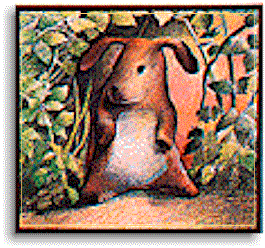|
Over the years, many diverse and unusual events have taken
place in the Bar Association's Common Room, but surely none
so delightful as the premiere public performance of Simon Chan's
musical version of The Velveteen Rabbit. The small audience,
in which the librettist and composer's colleagues from the Bar
were outnumbered by his friends from the theatrical world, may
live to remember the event when both the work and its creator
have become household names.
Chan's work is inspired by, rather than being strictly an
adaptation of, the first and most popular of about 30 children's
books written by Margery Williams (1881-1944). Chan's
is not the first attempt to stage Williams' story: at least
two other musical versions, one stage play, and one ballet,
have all drawn their inspiration from the same text. And
it is not difficult to see how Chan and others have been inspired
by the uplifting story of a stuffed toy which craves to become
real, and achieves that ambition through a small boy's love.
Chan's music is, in a word, masterful. His simple yet
memorable melodies are entirely sympathetic to the story, underpinning
- rather than distracting attention from - the dramatic development.
Even allowing for Chan's advantage of having a very talented
ensemble cast, it is apparent that he has a gift for musical
theatre which is more than worthy of the professional stage.
The range of musical styles displayed in a production lasting
only a little over 30 minutes may seem confusing on paper, but
the reality is very different.
After a short instrumental overture, the scene is set with
The Dewdrop Fairy's song, The Velveteen Rabbit, which is unmistakably
operatic in character - not in the imposing coloratura style
of, say, Bellini or Donizetti, but with a simpler melody and
harmonic progressions more reminiscent of, say, Gluck or Monteverdi.
Perhaps this impression is at least partly attributable
to the clarity of Sarah Sullivan's superb performance in the
role of The Dewdrop Fairy.
The mood and tempo changed entirely with two songs, Choo-Choo
Cha-Cha and It Ain't No Rabbit, both performed by Ralph Devlin
(in the separate roles of Steamy the toy battleship and Harold
the rabbit) and Katrina Devery (again in separate roles, as
Choo-Choo the toy train and Gwenda the rabbit). Devlin's
experience in the "Grossmith roles" of the Gilbert and Sullivan
repertoire served him well in Steamy's duet with Choo-Choo,
containing such sneering lines as:
My ancestors
played with Prince Edward the third.
My
mother belonged to a Duke.
We're
bearers of standard
Both
worshipped and pandered
And
anything crass makes us puke.
The more raunchy duet between Harold and Gwenda owes much,
both in lyrics and tempo, to the jazz tradition, rather in the
way that George and Ira Gershwin, or Kurt Weill and Bertolt
Brecht, borrowed from the idioms of jazz.
The show's smash hit, however, was surely the song Real,
performed with great delicacy by Barbara Fordham in the production's
title role. Whilst the song's simple yet rhetorical lyrics
bring Noel Coward to mind, the plaintive melody could have been
written by Andrew Lloyd Webber, by Frederick Loewe, or even
by Richard Rodgers at his sentimental best. Inviting the
audience to participate in a reprise of this magical song quickly
demonstrated the accessibility and catchiness of the tune.
Other memorable features were the songs One Perfect Day (Sarah
Sullivan as The Dewdrop Fairy), All Through The Night (Barbara
Fordham as The Velveteen Rabbit), and The Use of Love (first
performed by Barbara Fordham as The Velveteen Rabbit, and then
reprised by Sam Vincent as The Boy).
Richard Wagner - perhaps immodestly - proposed that opera
was the highest form of art, combining literature, music and
the decorative arts. As this performance was merely a
reading, with no stage set and very limited costuming, the decorative
arts did not have much of a look in. But the synthesis
of literature and music was a joy for everyone who had the privilege
to attend.
The traditions of musical theatre, over the last century,
have brought together a great diversity of musical forms, from
operatic and (so-called) classical music, to folk and popular
music, to jazz and even rock music. This panoply is well
represented by Chan's work, which seems to take its inspiration
from a profound understanding of, and love for, the theatrical
music genre. Irving Berlin, Cole Porter or Jerome Kern
could have been extremely proud, had their first works to be
performed publically exhibited the qualities and promise of
Simon Chan's The Velveteen Rabbit, or had they been so enthusiastically
received by their first audiences.
In a city the size of Brisbane, it should come as no surprise
to find people as talented as Simon Chan living in our midst.
Yet, to our shame, we tend to assume that anyone with
real musical or literary gifts lives interstate or overseas
- either because they were born there, or because they have
had to move there in order to gain recognition. One can
only hope that those responsible for the promotion and funding
of art in Queensland will recognise, before it is too late,
the benefits of nurturing home-grown talent.
More than a century ago, WS Gilbert eked out an existence
at the English Bar, waiting for the break which ultimately came
through his immortal partnership with Sir Arthur Sullivan, and
the great popular and commercial success of their collaborative
works. The Queensland Bar should feel privileged that
it, likewise, can provide a home to a man as talented as Simon
Chan, until - inevitably - he goes on to achieve a level of
fame and success which his erstwhile colleagues at the Bar could
only dream of.
|

